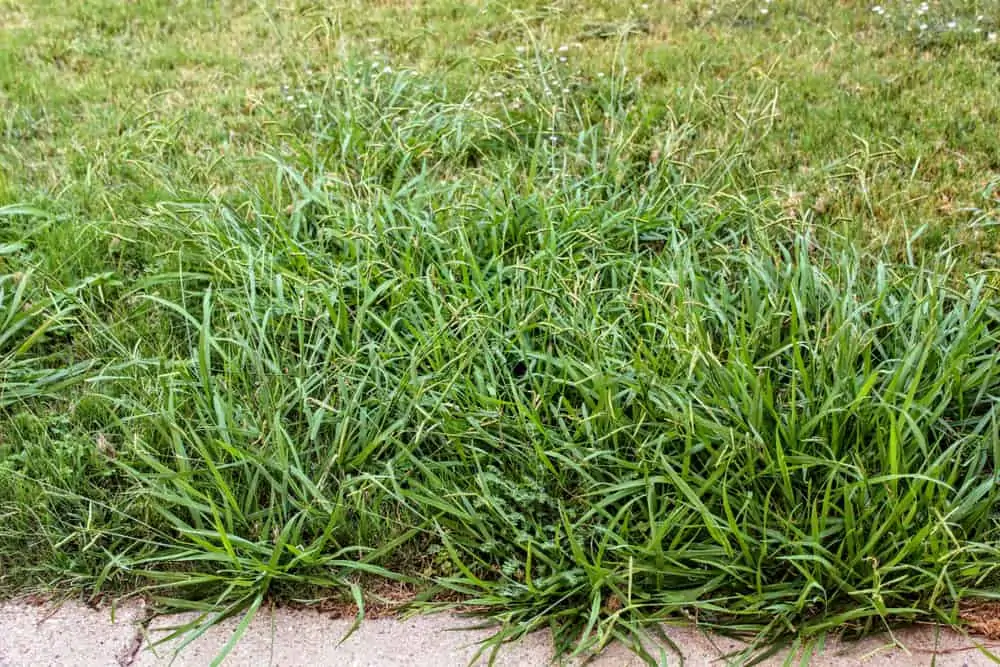Prevention is the key to completely wiping out crabgrass on your lawn and you’ll want to take precautions before the issue becomes out of your control. You’ll need to apply a crabgrass preventer or a pre-emergent herbicide before the crabgrass seedlings even begin to germinate and emerge which is in the early spring to late summer when the soil temperature is optimized for its growth.
Crabgrass seeds start germinating when the temperature of the soil is around 55 degrees Fahrenheit for around a week at a time. If you’re unsure about knowing whether the temperature of your soil is the optimum temperature for crabgrass seeds to germinate, then you can buy yourself a soil thermometer from a garden center so you can apply your crabgrass prevent at the correct time.

If you live in an area that experiences warmer winter months, then you could look about applying the pre-emergent herbicide a lot earlier than most other people.
If you’ve missed the prevention stage and you’re already seeing a growth of crabgrass on your lawn, then you’ll need to use a post-emergent herbicide. You should apply this herbicide in the morning when the temperature is cooler and look to apply it twice within a 4 to 10 period.
Table of Contents
How do I get rid of crabgrass in my yard?
If you’re going to be using a pre-emergent herbicide to prevent crabgrass on your yard then you’ll want to seek to apply it when the soil temperature hits around 55 degrees Fahrenheit as a daily occurrence, or you’ll notice that you’ll start to some shoots or blooms of flowers and greenery appearing in your yard.
If you’ve only just recently seeded your yard, then you should wait until you’ve mowed your lawn three times before applying the preventative herbicide otherwise you risk killing your fresh grass seedlings.
You should apply the pre-emergence herbicide across your whole yard in a uniform manner and not just focussing on areas that are prone to having crabgrass growth. Any areas you miss gives the crabgrass a chance to grow and then spread to other areas of your lawn.
Do not aerate your lawn once you’ve applied the pre-emergent herbicide as it’ll pull it up from the surface and then it’ll be ineffective at preventing the crabgrass.
You should waist to reseed your lawn after 2 to 4 months after applying the herbicide. You should try to use a pre-emergent herbicide as early as possible, preferably late winter or early spring to prevent any crabgrass seeds from developing when your lawn also starts to grow.
However, you should not be using a pre-emergent herbicide or a crabgrass preventer if there is crabgrass already present on your lawn. You will now have to use a post-emergent herbicide or known as crabgrass killer.
You should only apply this crabgrass killer to crabgrass that is visible on your lawn and not cover your entire lawn with it. The amount of herbicide you can apply to your lawn will depend on what type of lawn seed you use, so you’ll need to check the product description of the herbicide before distributing it on your lawn.
If your soil or lawn is not moist before applying your herbicide, then you’ll need to water it well with a hose or a sprinkler system beforehand. If you live in a particularly dry climate, then you’ll want to water the treated area two days after you’ve applied the herbicide as well.
You should try to apply the herbicide on a regular sunny day when there is no chance of rainfall within the following days as this reduces the risk of the herbicide not being absorbed. You should apply it in the morning after the morning dew on the surface of the lawn has dried.
Crabgrass killer works most effectively during warmer temperatures between 60 to 90 degrees Fahrenheit as they can be absorbed more quickly by the grass.
If you don’t think the herbicide was effective after a week, then you’ll need to reapply the herbicide to the required areas. Whilst going through this process, you should always keep an eye out for newly germinated crabgrass that may have grown during the treatment period.
Does baking soda really kill crabgrass?
Yes, baking soda is effective in killing crabgrass and almost any other plant it comes into contact with, this is due to the phytotoxic effects that are produced by the sodium content.
You should water the weeded area by applying the baking soda powder to the required zone. Give the baking soda a few days to kill the weeds and then you will need to uproot the dead crabgrass and reseed or replant the grass in its place.
How do you kill crabgrass without killing your lawn?
If your lawn begins to turn brown suddenly after the application of the herbicide, then you have applied too much. You should water the browned area considerably to try and dilute the herbicide and prevent your lawn from further damage.
The best way to keep your lawn in good condition whilst effectively targeting the crabgrass is by using a selective post-emergent crabgrass killer, this will kill the weeds without damaging your lawn.
You could always try using homemade remedies to wipe out the crabgrass, such as vinegar or baking soda. It’s best to use homemade remedies on targeted areas of your crabgrass instead of over the entire lawn as it could affect the health of your lawn.
Is water grass and crabgrass the same thing?
Watergrass is a name that is often used to refer to several plants. Crabgrass is often referred to as ‘water grass’ along with another weed called yellow nutsedge.
